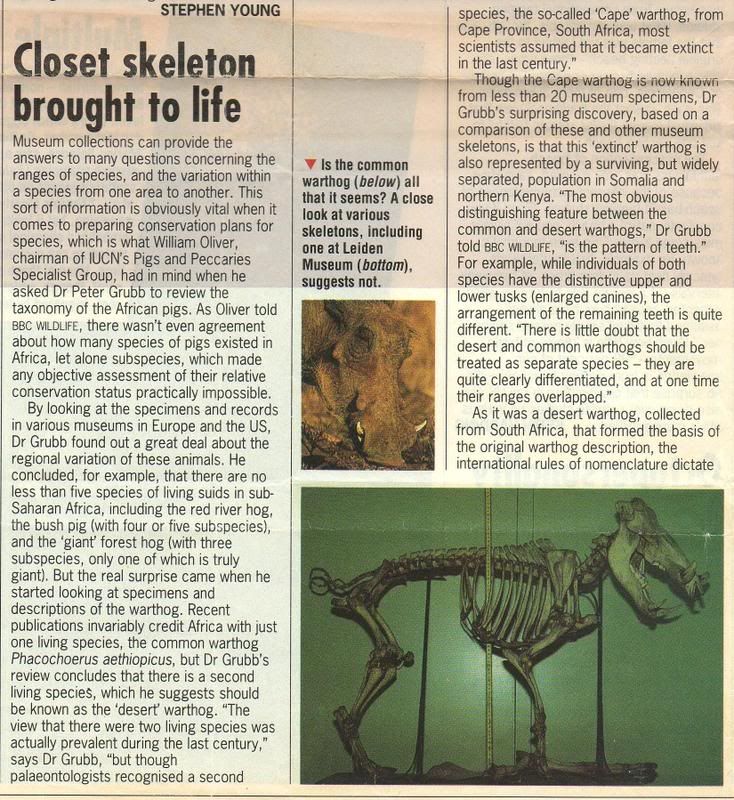|
|
Post by another specialist on Jun 25, 2008 19:34:37 GMT
|
|
|
|
Post by another specialist on Jun 25, 2008 19:59:29 GMT
Evidence of two genetically deeply divergent species of warthog, Phacochoerus africanusand P. aethiopicus (Artiodactyla: Suiformes) in East Africa E. Randia, , , J.-P. DŒHuartb, , V. Lucchinia and R. Amanc, aIstituto Nazionale per la Fauna Selvatica, Ozzano dell'Emilia, Bologna, Italia bWWF Belgium, Brussels, Belgium cNational Museum of Kenya, Nairobi, Kenya Received 3 January 2001; accepted 30 May 2001. Available online 18 November 2004. Summary Two species of warthogs (Phacochoerus), differing by the number of functional incisors, were described in the Holocene fossil record: the common warthog (P. africanus), widespread in sub-Saharan Africa, and the Cape, or desert warthog (P. aethiopicus), which was considered extinct since 1896, but was recently rediscovered in East Africa by morphological analyses. Mitochondrial and single-copy nuclear DNA sequences show that common and desert warthogs belong to two deeply divergent monophyletic lineages, that might have originated in the last part of the Pliocene. The finding of two genetically divergent extant species of warthogs highlights the importance of molecular methods applied to the knowledge and conservation of biodiversity in Africa, to uncover the tempo and mode of its species evolution. Key words: Phacochoerus aethiopicus; P. africanus; mtDNA; PRE-1; East Africa www.sciencedirect.com/science?_ob=ArticleURL&_udi=B7GX2-4DTSN38-B&_user=10&_coverDate=01%2F01%2F2002&_alid=759119758&_rdoc=6&_fmt=high&_orig=search&_cdi=20474&_sort=d&_docanchor=&view=c&_ct=6&_acct=C000050221&_version=1&_urlVersion=0&_userid=10&md5=88d70cf4d7f61d5018d244d5eb70266b |
|
|
|
Post by another specialist on Jul 13, 2008 18:34:46 GMT
SUBSPECIES Phacochoerus aethiopicus aethiopicus Author: Pallas, 1766. Citation: Misc. Zool.: 16. Type Locality: "Promontoria Bona Spei advectus"; between Kaffraria and Great Namaqualand (South Africa, Eastern Cape Prov.), two hundred leagues from the Cape of Good Hope according to Vosmaer (1766). www.bucknell.edu/msw3/browse.asp?s=y&id=14200020 |
|
|
|
Post by another specialist on Aug 10, 2008 15:27:29 GMT
The image and pic of the original article:"   Peter do you still have this images saved some where? Found the article so rescanned and here it is.   |
|
|
|
Post by another specialist on Aug 10, 2008 15:58:43 GMT
|
|
|
|
Post by another specialist on May 1, 2009 7:31:05 GMT
|
|
Deleted
Deleted Member
Posts: 0
|
Post by Deleted on Dec 23, 2010 15:10:55 GMT
Cape Warthog ( Phacochoerus aethiopicus aethiopicus)  from 'Proceedings of the Zoological Society of London 1850, 78-79' |
|
|
|
Post by Peter on Jun 10, 2012 6:12:37 GMT
|
|
|
|
Post by surroundx on Jun 7, 2015 5:50:11 GMT
|
|
|
|
Post by surroundx on Jun 7, 2015 7:16:16 GMT
|
|
|
|
Post by surroundx on Mar 13, 2016 9:39:37 GMT
Taru, Phillip. (2016). Fossil hair in brown hyaena ( Parahyaena brunnea) coprolites from Middle Pleistocene deposits at Gladysvale Cave, South Africa. Palaeobiodiversity and Palaeoenvironments. DOI: 10.1007/s12549-015-0227-7 [ Abstract] |
|
|
|
Post by Sebbe on May 12, 2017 20:34:37 GMT
|
|